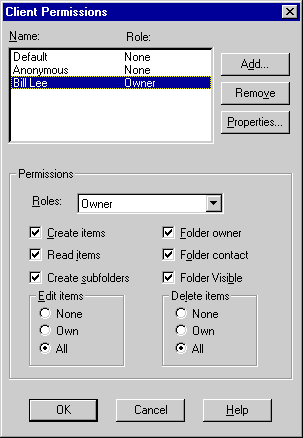
| Getting Started | << | >> |
|---|
Permissions define the extent to which users can work with items in a folder. Roles are sets of permissions that define how much access users have to a public folder. You can grant permissions to new users or modify permissions for existing users.
Note To edit or delete items in a public folder or to view the names of other folder users, you must have Owner permissions in that folder.

Use the Client Permissions dialog box to grant permissions to new users. When granting permissions, you can choose from the roles provided by Microsoft Exchange Server or select individual permissions.
To set permissions for new users or groups, use the following procedure.
| Option | Description |
|---|---|
| Add | Opens the Add Users dialog box, where you can select user, distribution list, or public folder names to add to the Name/Role box. |
| Remove | Removes the selected name from the Name/Role box. |
| Properties | Displays details about the selected name. |
| Permissions | Controls the access that users have to a public folder. When you select individual permissions, the matching role name appears in the Roles box. If there is no matching role, Custom is displayed. |
| Roles | Selects a role to grant the set of permissions associated with that role. You cannot select Custom; it is displayed automatically. |
| Edit items | Grants users permission to cut, paste, delete, and undo items in a public folder. |
| None | Prevents users from editing the items in a public folder. |
| Own | Grants users permission to edit items only in their own folder. |
| All | Grants users permission to edit all items in the public folder. |
| Delete items | Grants users permission to delete items in a public folder. Only public folder owners can delete an entire folder. |
| None | Prevents users from deleting items in a public folder. |
| Own | Grants users permission to delete items only in their own folder. |
| All | Grants users permission to delete all items in a public folder. |
Microsoft Exchange Server provides the following roles.
| Role | Description |
|---|---|
| Owner | Grants users all permissions in the folder. |
| Publishing Editor | Grants users permission to create items, read items, edit and delete any item, and create subfolders. |
| Editor | Grants users permission to create items, read items, and edit and delete any item. |
| Publishing Author | Grants users permission to create items, read items, edit and delete their own items, and create subfolders. |
| Author | Grants users permission to create items, read items, and edit and delete their own items. |
| Nonediting Author | Grants users permission to read items, create items, and delete their own items. |
| Reviewer | Grants users permission to read items. |
| Contributor | Grants users permission to create items. |
| None | Grants no permissions in the folder. Use this as the default permission when you want to limit the folder's audience to the users you specifically add to the Name/Role box. |
Microsoft Exchange Server provides the following permissions.
| Permission | Description |
|---|---|
| Create items | Grants users permission to create new items in the folder. |
| Read items | Grants users permission to read any items in the folder. |
| Create subfolders | Grants users permission to create subfolders within this public folder. |
| Folder owner | Grants users permission to be the owner of the folder. |
| Folder contact | Grants the user permission to act as the contact for folder-specific messages, such as conflict messages. |
| Folder Visible | Grants users permission to view this folder in the public folder hierarchy. |
To modify the permissions existing users have for a public folder, use the Client Permissions dialog box.
Note When a subfolder is created, it inherits the client permissions set on the parent folder. After the subfolder is created, its permissions can be modified independently of the parent folder.